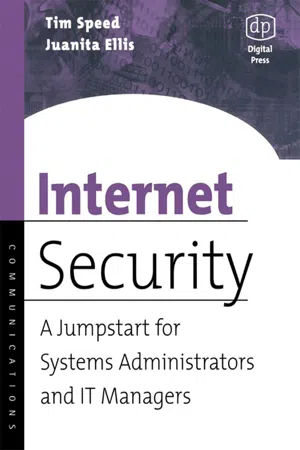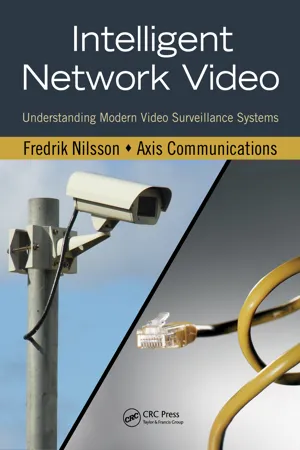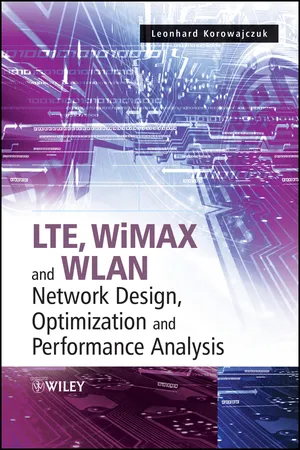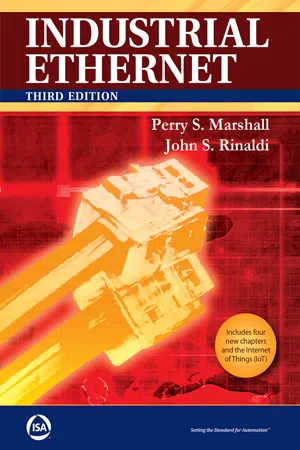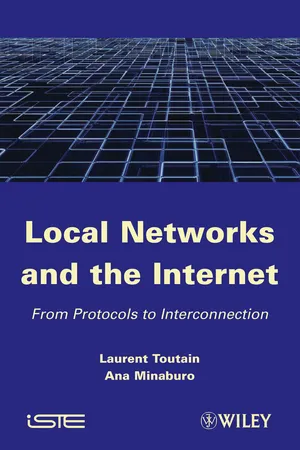Computer Science
Transmission Control Protocol (TCP/IP)
Transmission Control Protocol/Internet Protocol (TCP/IP) is a set of communication protocols used for connecting network devices on the internet. TCP ensures that data packets are delivered reliably and in the correct order, while IP is responsible for addressing and routing packets to their destination. Together, TCP/IP forms the foundation of internet communication, enabling seamless data transmission across diverse networks.
Written by Perlego with AI-assistance
8 Key excerpts on "Transmission Control Protocol (TCP/IP)"
Learn about this page
Index pages curate the most relevant extracts from our library of academic textbooks. They’ve been created using an in-house natural language model (NLM), each adding context and meaning to key research topics.
- eBook - ePub
- Lawrence J. Fennelly(Author)
- 2019(Publication Date)
- Butterworth-Heinemann(Publisher)
This may be one of the most important sections in the book. The designer who does not thoroughly understand Transport Control Protocol/Internet Protocol (TCP/IP) is at a severe disadvantage in design, in construction management, and in system commissioning. The designer is at the mercy of installers and physics, both of which can harm him or her. Not understanding TCP/IP is like not being able to read or write. This is not a comprehensive tome on TCP/IP. I suggest that the reader may buy several other books on the subject. This description is intended for the novice designer.Basics of Transport Control Protocol/Internet Protocol and signal communications
TCP/IP is the basic protocol of digital systems. From the understanding of that protocol, all knowledge about digital systems flows.How Transport Control Protocol/Internet Protocol works
The purpose of TCP/IP is to guide information from one place to another on a digital network. In the beginning, when computers were owned only by the government, military, universities, and really big business (banks and insurance companies), computers were not networked. Universities and the military held discussions on how to network their machines. The first network, called ARPANET, was developed in 1969 using Network Control Protocol, an early predecessor to TCP/IP. Although this permitted limited communications, several problems were evident, mainly that computers could only talk to other computers of the same manufacturer using the same operating system and software. This was not good, since the whole idea was to allow communication, not to limit it. After several iterations, TCP/IP evolved. I will not go into the entire long story; you can look that up on Google under “TCP/IP history.” TCP/IP is really two separate protocols. TCP is the Transport Control Protocol, and IP is the Internet Protocol. TCP was developed in 1974 by Kahn and Cerf and was introduced in 1977 for cross-network connections. TCP was faster, easier to use, and less expensive to implement. It also ensured that lost packets would be recovered, providing quality of service to network communications. In 1978 IP was added to handle routing of messages in a more reliable fashion. TCP communications were encapsulated within IP packets to ensure that they were routed correctly. On the receiving end the TCP packets were unpacked from their IP capsules. Experts quickly realized that TCP/IP could be used virtually for any communication medium, including wire, radio, fiber, and laser, as well as other means. By 1983, ARPANET was totally converted to TCP/IP, and it became known as the Internet. - eBook - ePub
Internet Security
A Jumpstart for Systems Administrators and IT Managers
- Tim Speed, Juanita Ellis(Authors)
- 2003(Publication Date)
- Digital Press(Publisher)
Figure 1.2 , the source computer, Computer 123, sends a packet of data on a network. This network is called Network A. The data packet travels over the network looking for Computer 124. Once found, it delivers the packet to the computer.Figure 1.2TCP/IP address works much like the postal mail analogy. Every computer has a source address, and if you want to send data to another computer, you need to know its “target” address.The Transmission Control Protocol/Internet Protocol provides connectivity between equipment from many vendors over a variety of networking technologies. The Transmission Control Protocol (TCP) is intended for use as a highly reliable host-to-host protocol between hosts in packet-switched computer communication networks.The Internet Protocol (IP) is specifically limited in scope to provide the functions necessary to deliver an envelope of data from one computer systemto another. Actually, we are not limited to PCs. This can be any network-connected device, a computer, a printer, a cell phone (see WAP in the glossary). Each computer or device on a network will have some type of address that denotes where it is on the network. Every device will have one of these addresses, assigned via a permanent mechanism or a temporary addressing scheme. You will notice that we are referencing a network; IP and TCP are used on the Internet but also can be used on any network. Many networks use TCP/IP as their primary protocol.When data is sent via a network (e-mail note or a web page), the data (or message) is carved into little chunks called packets. The packets contain the information required to determine who sent the message as well as the reception of the message.An Ethernet LAN typically uses some type of cable or special grades of twisted pair wires. Basically, the computer is connected to the cable via a card (or NIC, Network Interface Card) and that NIC card puts the data onto the cable. In our examples for your home network we will be discussing the Ethernet LAN. This is a complex system, known as Carrier Sense Multiple Access with Collision Detection (CSMA/CD), that keeps data from running into each other. Every NIC card will have some type of address. This address is known as a MAC address and is typically a 48-bit address that is unique for every card. All Ethernet data is crafted into packets with each packet having the information needed to find its target computer and knowing where it came from. Figure 1.3 - eBook - ePub
Intelligent Network Video
Understanding Modern Video Surveillance Systems, Second Edition
- Fredrik Nilsson, Communications Axis(Authors)
- 2016(Publication Date)
- CRC Press(Publisher)
TCP/IP stands for Transmission Control Protocol/Internet Protocol, and in the TCP/IP reference model, the protocols fall into four different layers, which correspond to the seven layers in the OSI model as shown in Figure 11.2. 11.2.1 Internet Protocol The IP is a Layer 3 protocol in the OSI model and a Layer 2 protocol in the TCP/IP Reference Model. It is the key protocol in most of today’s networked applications. For a server to operate on the internet, it must have its own, individual, public IP address. The Internet Corporation for Assigned Names and Numbers is a nonprofit global organization that has been designated to conduct the registrar accreditation process. An IP address can be assigned by an internet service provider (ISP), which can allocate either a dynamic IP address, which can change from session to session, or a static address, which is normally provided for a monthly fee. IP offers a connectionless service that splits data into IP datagrams before they are transmitted. Connectionless means that IP does not guarantee whether or in what sequence IP datagrams will arrive at a recipient. Because IP operates on a connectionless basis, individual IP datagrams can be routed to a recipient via different paths. Guaranteed data transmission and reassembly into the correct sequence are performed by protocols in the transport layer of the OSI and TCP/IP models. There are currently two versions of IP: IPv4 and IPv6. IPv6 is slowly replacing IPv4, but this older version still provides the vast majority of the service today. The significant difference between the two IP versions is the size of the address space, which is substantially larger in IPv6. Figure 11.2 The TCP/IP reference model can be split into four layers (right), which is comparable to the seven layers in the Open Systems Interconnection model (left). 11.2.2 IPv4 addresses An IPv4 address is 32 bits long, meaning that 2 32, or 4.3 billion (4,294,967,296), unique IP addresses can be assigned - Leonhard Korowajczuk, Leonhard Korowajczuk(Authors)
- 2011(Publication Date)
- Wiley(Publisher)
UDP is a very simple protocol for data exchange as it does not guarantee reliability, ordering or data integrity. It just packs the data in datagrams and sends them to the destination. It is a very efficient protocol, with little overhead and processing and is ideal for applications that are not affected by receiving some frames in error or by missing frames. This protocol identifies the sender and destination ports.2.7.2 Transmission Control Protocol (TCP)TCP concerns only with the end-to-end connection and provides a reliable and orderly stream of bits. TCP controls segment size, flow control, rate and network traffic congestion. TCP relies on IP to carry its messages, segmenting the data and numbering sequentially these segments. The TCP header format of these segments is shown in Figure 2.6 .A TCP data transfer has several phases:Figure 2.6 Transmission control protocol header.- Connection establishment: server and client synchronize to a random sequence number SYN (Synchronized Sequence Number).
- Data transfer is made according to following directives:
- Retransmission of lost packets.
- Discard of duplicate packets.
- Error-free data transfer.
- Ordered data transfer.
- Control flows to avoid host overflow.
- Congestion control through sliding window.
- Connection termination: A four-way handshake is done with a FIN (Finish) and
- ACK (Acknowledgement) package from each side.
A port is a logical process-specific software construct serving as a communications endpoint used by UDP and TCP. A port is identified by its number. The Internet Assigned Numbers Authority (IANA) is responsible for assigning and registering port numbers. The following are the port ranges:- Well-known ports: 0 through 1023.
- Port 23: Telnet
- Port 53: DNS (Domain Name System)
- Port 80: WWW
- Registered ports: 1024 to 49151.
- Dynamic or private ports: 49152 to 65535.
When a device wants to communicate with another device outside its subnet over an IP network, it must pass its address, the destination address and the data to a router. The IP router must know how to transfer this data to the destination or at least forward it towards the destination. The router will use a routing algorithm to find the best route to the destination.- eBook - ePub
- John Marshall(Author)
- 2017(Publication Date)
- International Society of Automation(Publisher)
Figure 4-3 .Protocols in this suite work together by passing their messages up and down the protocol stack. For example, the TCP protocol (described later in this chapter) takes application data and embeds it in the data field of a TCP message. It then passes the TCP message to the IP protocol where the entire TCP message becomes the data packet of the IP message. At each layer of the TCP/IP protocol suite, the software layer is only concerned with its fields and not the contents provided by previous layers.The TCP/IP protocol suite is software and is usually a component of your computer’s operating system. In Microsoft Windows(R) , Microsoft includes a TCP/IP protocol suite to processEthernet messages. In industrial devices, the TCP/IP protocol suite may be included as part of an operating system or may be a separate software component. The number of programs included in the suite is dependent on the vendor but always includes both the Internet Protocol (IP) and Transmission Control Protocol (TCP).Figure 4-3. Data Flow Through the Hardware, IP Layer, and UDP/ TCP Layers to Applications4.4TCP/IP Protocol Suite – IP ProtocolThe IP part of the Internet Protocol Suite is the “Internet Protocol.” It is used for almost all Internet communication. When a host sends a packet, it figures out how to get the packet to its destination; when receiving packets, it figures out where they belong. Because it does not worry about whether packets get to where they are going, nor whether they arrive in the order sent, its job is greatly simplified. If a packet arrives with any problems (e.g., corruption), IP silently discards it.In addition to inter-network routing, IP provides error reporting and fragmentation and reassembly of packets for transmission over networks with different maximum data unit sizes. IP provides several services: - eBook - ePub
- David Austerberry(Author)
- 2013(Publication Date)
- Routledge(Publisher)
These potential problems are corrected by the higher layer protocols and applications. The most well-known protocol is at the transport layer, Transport Control Protocol (TCP). This is used together with Internet Protocol – the ubiquitous TCP/IP. One of the great strengths of TCP is its reliability. The built-in error protection of TCP makes it an excellent protocol for the delivery of general purpose data, but the way this is implemented proves to be a disadvantage for streaming applications. TCP sequences the data bytes with a forwarding acknowledgement number that indicates to the destination the next byte the source expects to receive. If bytes are not acknowledged within a specified time period they are retransmitted. This feature of TCP allows devices to detect lost packets and request a retransmission. The repeated transmission will add to the communication latency, but that is not normally an issue with data exchange. TCP also provides flow control of the data. With audio and video, the viewer requires a continuous stream to view the source in real-time. Retransmission of data is going to add delays; retransmission also uses up bandwidth in the data channel. Ultimately, high levels of network transmission errors will empty the receive buffer in the media player. The interruption to the stream will ultimately will lead to interruptions to the video playback. The alternative is to ignore lost packets. This may cause loss or distortion of a single video frame, but that is a transient event that will be ignored by the viewer. So for real-time applications, timely delivery is more important than error-free transmission.User Datagram Protocol (UDP)
Streaming needs a transmission protocol that can ignore data errors. Such a protocol is the User Datagram Protocol (UDP). It is used as a transport protocol for several application-layer protocols, notably the Network File System (NFS), Simple Network Management Protocol (SNMP), and the Domain Name System (DNS). UDP has neither the error correction nor the flow control of TCP, so this task has to be handled by an application at a higher layer in the stack. It does, however, carry a checksum of the payload data. The media players can often mask video data errors. - eBook - ePub
Local Networks and the Internet
From Protocols to Interconnection
- Laurent Toutain, Ana Minaburo(Authors)
- 2013(Publication Date)
- Wiley-ISTE(Publisher)
Chapter 7IP Protocols
This chapter starts the section of the book dedicated to Internet network protocols. It covers the network organization and level 3 protocols (IP and associated protocols). This chapter also deals with the new version of the IP protocol, called IPv6. Chapter 8 will present level 4 protocols: UDP (User Datagram Protocol) and TCP (Transmission Control Protocol); and Chapter 9 the methods used to link the different protocol layers (ARP, RARP, DNS).7.1. Implementation of the TCP/IP protocols
The IP protocol transfers data in datagram mode, i.e. packets are processed independently. This allows us to have relatively simple and fast equipment within the network. The protocol was designed to ensure the routing and segmentation of data (adaptation of packet length to the size of data carried by level 2 frames).The goal of the IP protocol is to be able to build a worldwide network by adapting to every type of physical medium. RFCs defining the encapsulation rules of IP packets are:— Broadcast local network such as Ethernet (RFC 894, see Chapter 3 , page 37).— Point-to-point links with PPP (see Chapter 16 ).— Traveling pigeons (RFC 11491 );— X.25 (RFC 1356);— Frame relay (RFC 1490, see section 15.3 );— ATM (RFC 1483, RFC 1577); — SDH (RFC 1619); — WiMAX (working group 16 ng); — DVB (working group ipdvb); — Sensor networks (working group 6 lowpan); — Etc.In a network, we can distinguish two types of equipment (see Figure 7.1 ). Equipment that is found at the end of the network (work stations, personal computers, printers, etc.) and that produce or consume data and routers located inside the network.Figure 7.1.Simplified architecture of the network7.1.1. Terminal equipment
Figure 7.2 - eBook - ePub
VoIP and Unified Communications
Internet Telephony and the Future Voice Network
- William A. Flanagan(Author)
- 2012(Publication Date)
- Wiley(Publisher)
TCP protects sessions against transmission errors and lost packets, but at a cost in memory usage, processor cycles, and potential added delay. It is “connection-oriented” because hosts that want to exchange packets must first open a session between them with an exchange of control packets (SYN and ACK). TCP is also “stream oriented” in dealing with octets rather than messages or transactions, per se.To allow a correction, the sender holds packets until they are acknowledged as received OK. If no acknowledgment comes before a time-out period, or the receiver sends a retransmission request, the packet is sent again. These features make TCP a “reliable” protocol.The TCP receiver uses the sequence number to identify missing data and to ensure the content from multiple packets is assembled in the correct order before that content reaches the software process handling that payload. The TCP header is shown in Figure 4.6 . Note that RFC 793, from 1981, while still in effect at this writing, has been updated in RFC 1122.FIGURE 4.6 Transmission Control Protocol header layout. TCP maintains sessions so that it can retransmit packets when necessary to correct errors.TCP provides a multiplexing function to connect multiple host processes at a single IP address to other hosts with multiple processes behind one IP. The source and destination port numbers identify the process at each end. Some port numbers are “well known” from a permanent assignment by IANA to a protocol; for example, port 80 is designated for HTTP. The six control bits coordinate the protocol between the two end points. Each is set to 1 to activate that function. The IP addresses and TCP port numbers at each end (four fields) define a session.As a stream-oriented protocol, the sequence numbers apply to octets in a stream, not to packets. In effect every octet has a sequence number assigned to it by the sender. The initial number is random; then increments for each octet transmitted. ACKs use the sender’s numbering to confirm safe receipt of octets to a certain point.

